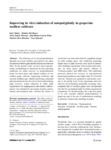Please use this identifier to cite or link to this item:
http://www.alice.cnptia.embrapa.br/alice/handle/doc/979552| Title: | Improving in vitro induction of autopolyploidy in grapevine seedless cultivars. |
| Authors: | SINSKI, I.  BOSCO, D. D.   PIEROZZI, N. I.   MAIA, J. D. G.   RITSCHEL, P. S.   QUECINI, V.   |
| Affiliation: | IRACI SINSKI, CNPUV; DANIELA DAL BOSCO, CNPUV; Neiva Izabel Pierozzi, IAC; JOAO DIMAS GARCIA MAIA, CNPUV; PATRICIA SILVA RITSCHEL, CNPUV; VERA MARIA QUECINI, CNPUV. |
| Date Issued: | 2014 |
| Citation: | Euphytica, Wageningen, v. 196, n. 2, p. 299-311, 2014. |
| Description: | The efficiency of in vitro polyploidization depends on several variables associated to the plant, the antimicrotubule agent and the interactions between them. In the present work, we have used response-surface methodology to determine the best operating conditions for plant recovery in polyploidization assays for shoot apices and somatic embryos of two seedless grape cultivars, employing colchicine and oryzalin. Explant type, tubulin-interfering compound and concentration were the critical factors determining plant recovery. Linear reduction in viable plant regeneration via organogenesis and somatic embryogenesis was obtained by increasing oryzalin concentrations and treatment time, whereas the effects of colchicine were better described by a quadratic design for both explants types. The conditions promoting higher rates of plant recovery were used in chromosome doubling experiments with oryzalin and colchicine for shoot apices and somatic embryos of ?Crimson seedless? and ?BRS Clara?. The established protocols allowed the recovery of non-chimerical autotetraploid plants at rates higher than 30 % for both cultivars. Stomata size parameters statistically correlate to the ploidy level of the regenerants and were effective for preliminary polyploidy screening. Autotetraploid lines of seedless grapes were incorporated into the Vitis germplasm bank for further agronomical evaluations. To our knowledge, this is the first report of in vitro oryzalin induced polyploidization of grapevine and of the use of mathematical modeling to optimize chromosome doubling in plants. |
| Thesagro: | Viticultura Uva Genética Poliploidia |
| Type of Material: | Artigo de periódico |
| Access: | openAccess |
| Appears in Collections: | Artigo em periódico indexado (CNPUV)  |
Files in This Item:
| File | Description | Size | Format | |
|---|---|---|---|---|
| EuphyticaPolyploidGrape1213.pdf | 760.24 kB | Adobe PDF |  View/Open |









